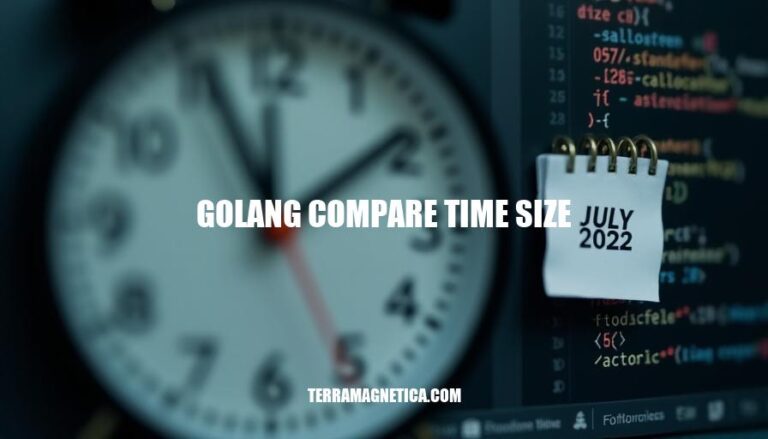


In Go (Golang), comparing time values is crucial for tasks like scheduling, logging, and measuring durations. Go provides built-in functions such as Before(), After(), and Equal() to compare time.Time instances. These functions help determine if one time is before, after, or equal to another, ensuring accurate time-based operations.
The Go time package provides robust functionality for handling and comparing time instances. Here are the key functions for comparing time sizes:
Before(t time.Time) bool: This method checks if the time instance is before the specified time t. For example:
t1 := time.Now()
t2 := t1.Add(2 * time.Hour)
fmt.Println(t1.Before(t2)) // true
After(t time.Time) bool: This method checks if the time instance is after the specified time t. For example:
t1 := time.Now()
t2 := t1.Add(-2 * time.Hour)
fmt.Println(t1.After(t2)) // true
Equal(t time.Time) bool: This method checks if two time instances are exactly equal. For example:
t1 := time.Now()
t2 := t1
fmt.Println(t1.Equal(t2)) // true
These functions are essential for comparing time instances in Go, ensuring accurate and reliable time-based operations.
In Go, you can use the Before() and After() methods from the time package to compare two time.Time values. Here’s how you can use them:
Before()The Before() method checks if a given time is before another time.
package main
import (
"fmt"
"time"
)
func main() {
t1 := time.Now()
t2 := t1.Add(24 * time.Hour) // t2 is 24 hours after t1
fmt.Println("t1 before t2:", t1.Before(t2)) // true
}
After()The After() method checks if a given time is after another time.
package main
import (
"fmt"
"time"
)
func main() {
t1 := time.Now()
t2 := t1.Add(-24 * time.Hour) // t2 is 24 hours before t1
fmt.Println("t1 after t2:", t1.After(t2)) // true
}
These methods return true or false based on the comparison. You can use them to determine the order of events or timestamps in your application.
The Equal() function in Go is used to compare two time.Time values to check if they represent the same instant. Here’s how you can use it:
func (t Time) Equal(u Time) bool
package main
import (
"fmt"
"time"
)
func main() {
t1 := time.Date(2023, 10, 4, 12, 0, 0, 0, time.UTC)
t2 := time.Date(2023, 10, 4, 12, 0, 0, 0, time.UTC)
fmt.Println(t1.Equal(t2)) // Output: true
}
package main
import (
"fmt"
"time"
)
func main() {
t1 := time.Date(2023, 10, 4, 12, 0, 0, 0, time.UTC)
t2 := time.Date(2023, 10, 4, 12, 0, 1, 0, time.UTC)
fmt.Println(t1.Equal(t2)) // Output: false
}
In these examples, t1 and t2 are compared using the Equal() function. The first example returns true because both times are identical, while the second example returns false because the seconds differ.
Here are some practical examples of comparing time sizes in Go:
Before and Afterpackage main
import (
"fmt"
"time"
)
func main() {
now := time.Now()
future := now.Add(2 * time.Hour)
fmt.Println("Now is before future:", now.Before(future)) // true
fmt.Println("Future is after now:", future.After(now)) // true
}
Equalpackage main
import (
"fmt"
"time"
)
func main() {
now := time.Now()
sameTime := now
fmt.Println("Now is equal to sameTime:", now.Equal(sameTime)) // true
}
time.Datepackage main
import (
"fmt"
"time"
)
func main() {
t1 := time.Date(2023, time.January, 1, 0, 0, 0, 0, time.UTC)
t2 := time.Date(2024, time.January, 1, 0, 0, 0, 0, time.UTC)
fmt.Println("t1 is before t2:", t1.Before(t2)) // true
fmt.Println("t2 is after t1:", t2.After(t1)) // true
}
Sub to get Durationpackage main
import (
"fmt"
"time"
)
func main() {
start := time.Now()
end := start.Add(10 * time.Minute)
duration := end.Sub(start)
fmt.Println("Duration between start and end:", duration) // 10m0s
}
time.Parse for String Comparisonpackage main
import (
"fmt"
"time"
)
func main() {
layout := "2006-01-02 15:04:05"
t1, _ := time.Parse(layout, "2023-01-01 12:00:00")
t2, _ := time.Parse(layout, "2024-01-01 12:00:00")
fmt.Println("t1 is before t2:", t1.Before(t2)) // true
fmt.Println("t2 is after t1:", t2.After(t1)) // true
}
These examples cover different scenarios for comparing time instances in Go.
Comparing time instances is a crucial aspect of time management in Go programming. The `time` package provides several functions to compare and manipulate time values, including `Before`, `After`, and `Sub`. These functions enable developers to determine the relationship between two time points, calculate durations between times, and parse string representations of time into time structs.
The `Before` function checks if a given time is before another time, while the `After` function does the opposite. Both functions return a boolean value indicating whether the first time is before or after the second time.
The `Sub` function calculates the duration between two times by subtracting one time from another, returning a `time.Duration` value representing the difference.
To compare time instances in Go, developers can use these functions to determine relationships between times and calculate durations. Understanding these functions is essential for effective time management in Go applications, ensuring accurate and efficient handling of time-related tasks.
When comparing time instances, it’s essential to consider the time zone and locale settings to avoid potential issues with time representation and comparison. The `time` package provides various functions to handle time zones and locales, such as `UTC`, `Local`, and `Parse`.
In addition to these built-in functions, developers can use third-party libraries or custom implementations to extend the functionality of time comparison in Go.
By mastering the art of comparing time instances in Go, developers can write more robust, efficient, and accurate applications that handle time-related tasks with ease.